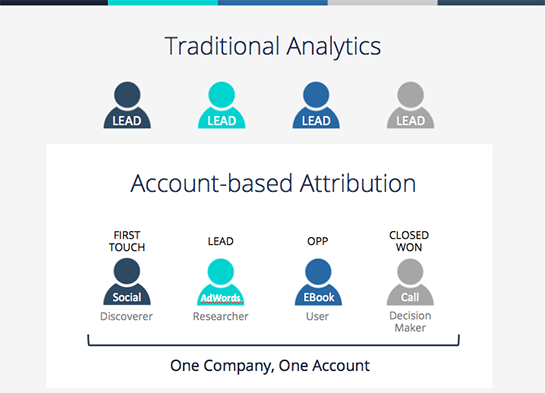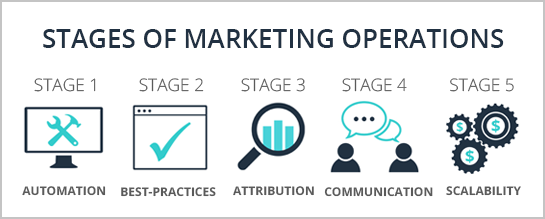A technical marketing operations role has been referred to as the unicorn of B2B marketing — you know they exist, but you can never find one.
They’re the role that attacks the data, operates the martech stack, consolidates the numbers, and optimizes the strategy. And really, really excellent ones are few and far between. Are you a unicorn? Have you found one? What do they look like?
Let’s outline the progression of a marketing operations role and watch as their pearly, white horn begins to extrude from their forehead. It’s never been a better time to be a B2B marketer, and marketing operations plays a key role in building a scalable revenue machine.
Find yourself in one of these stages, or notice any pieces that you may have missed along the way — either for yourself, your marketing operations personnel, or your marketing team as a whole.
[STAGE 1] Marketing Operations Owns and Operates Marketing Automation and MarTech Tools
The martech stack is the marketing operations playground. They’re responsible for developing lead criteria and scoring systems and then integrating that data with the CRM. They oversee nurturing processes, and monitor the metrics that all of these initiatives generate.
Also responsible for data hygiene, they structure the reporting processes and evaluate overall return-on-investment. This is the foundational function of a marketing operations role. They own the tech, use the tech, eat and breathe the tech, and share the tech with the rest of the team.
[STAGE 2] Marketing Operations Zeros In on Marketing Automation Best-Practices
Advancing from the basic role of marketing operations, a stage two marketing operations position emphasizes best practices and key processes. Their aim is to enhance effectiveness throughout the entire strategy, particularly concerning marketing strategy, data gathering, and the improvements that follow from the analytics they review.
It’s also their job to hone in on personas and firmographics, and they personalize the marketing plan to reach the precise target audience looking for what their company is selling. This serves to improve overall ROI and begin to reduce wasted ad spends.
Yet, as a marketer in this role becomes aware of the best methods to calculate ROI and decrease wasted marketing dollars, they begin to realize that they’re missing a critical piece of martech.
[STAGE 3] Marketing Operations Runs Attribution Software for Full-Funnel Data Tracking
The next step for a marketing operations role is to find a multi-touch marketing attribution solution. Attribution is the process of identifying the marketing touches (adwords, email, blog, social, outbound calls, etc.) that caused key conversions for prospects in their buying journey through the funnel.
This information shows marketing operations which marketing channels are most effective at converting prospects into leads, opportunities, and customers.
It presents a marketing operations analyst with clear, granular data that identifies which specific campaigns, keywords, and display ads bring in the most qualified leads, and they can capitalize on those best-performing activities.
Not only does this streamline the marketing strategy, but it also allows marketers to test their assumptions and see if the data backs up their suspicions about which marketing activities are bringing in the most leads.
And, especially for B2B marketers, with long sales cycles and multiple players that contribute to the buying decision, multi-touch attribution solutions can also provide account-based attribution. Account-based attribution collects all of the marketing touches instigated by people at a specific company into the same report.
[STAGE 4] Marketing Operations Acts as a Cross-Department Communication Hub
Once they have gathered, analyzed, and sorted the attribution data, they can share those insights with the marketing and sales teams. This essentially positions them as the communication link between departments in the company. Their access to detailed, clear data throughout the entire funnel makes their role even more essential, allowing them to participate in strategy talks centered on the bottom line.
They’re able to consult on all aspects of marketing, which helps them to improve business results as a whole. With their aggregated understanding of demand generation as a whole, they’re able to delve into the data, but they can also speak with a conceptual understanding. This skill of translation across departments allows them to fill a key role in a marketing team.
[STAGE 5] Marketing Operations Becomes the Architect of a Scalable Revenue Machine
Once the marketing operations department has straightened any kinks and ironed out the wrinkles, it’s then their responsibility to scale the marketing plan as the company continues to grow. When companies are smaller, hacks are permissible and unfortunate mishaps are easier to overlook. But it’s important to not allow those mistakes and malfunctions to scale with you.
A Stage-5 seasoned marketing operations role will correct those issues before they get out of hand, constantly developing the business’ marketing strategy to be better and bigger than it was the day before. Their pipeline marketing solution will scale seamlessly, allowing their organization’s revenue to grow without constraint.
And after all is said and done, they wake up the next morning with a fantastical pearly-white horn extruding from the top of their forehead.







